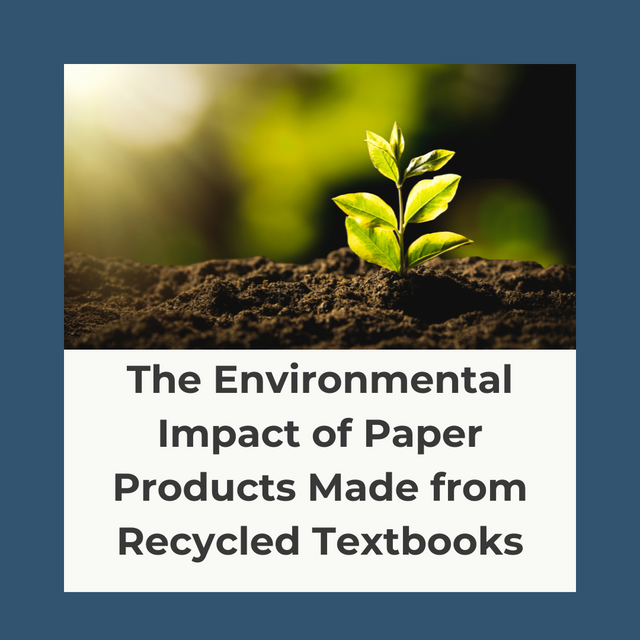7 Environmental Benefits of Paper Products Made from Recycled Textbooks
What are the environmental benefits of paper products made from recycled textbooks?
Introduction
Recycling has long been a cornerstone of sustainable practices, and the recycling of textbooks into new paper products is a brilliant example of how we can repurpose materials to benefit the environment and ensure no book is truly wasted. In this article, we delve into the environmental benefits of paper products made from recycled textbooks, showcasing how this innovative approach contributes to a zero waste future.
The Journey from Textbook to Recycled Paper Product
Understanding the Recycling Process
The process of transforming old textbooks into new paper products involves several key steps: collection, sorting, de-binding, pulping, deinking, and finally, creating new paper. Each step is designed to maximize the usability of the recycled material while minimizing environmental impact.
Key Players in Textbook Recycling
Many organizations and companies are dedicated to collecting and recycling textbooks. These entities ensure that the books are not wasted but are given a second life in various paper products. These organizations value the initial effort that originally went into the creation of a book. They also want to ensure that books of all kinds do not end up to rot in a landfill.
Major Environmental Benefits of Using Recycled Textbooks
Waste Reduction
Recycling textbooks significantly reduces the volume of waste sent to landfills. By repurposing old books, we divert thousands of tons of paper waste from becoming environmental pollutants.
Conservation of Natural Resources
Saving Trees and Forests
Every ton of recycled paper saves approximately 17 trees. By recycling textbooks, we directly reduce the demand for virgin paper, preserving forests and their ecosystems.
Water Conservation
The paper manufacturing process from virgin pulp is water-intensive. Recycling paper reduces the need for fresh water, conserving this precious resource.
Energy Savings
Lower Energy Consumption
Producing paper from recycled materials uses up to 60% less energy than producing it from raw materials. This energy saving translates into reduced greenhouse gas emissions.
Reduced Carbon Footprint
The energy savings achieved through recycling contribute to a lower carbon footprint, helping mitigate the effects of climate change.
Economic and Social Benefits of Recycling Textbooks
Job Creation
The recycling industry creates jobs in various sectors, from collection and processing to manufacturing new products. This economic boost can have positive ripple effects throughout communities. We have benefited this first hand in the Pacific Northwest as we employ people at our facility and also partner with recycling companies that are members in the Books Sustainability Project (insert link)
Education and Awareness
Recycling textbooks raises awareness about stewardship, sustainability and environmental responsibility. Individual schools, school districts and universities that engage in recycling programs educate students on the importance of conserving resources.
Innovations in Recycled Paper Products
Types of Recycled Paper Products
Recycled textbooks can be transformed into a variety of paper products, including notebooks, printer paper, and packaging materials. These products are often indistinguishable from those made from virgin pulp but come with added environmental benefits.
Advances in Recycling Technology
Technological advancements continue to improve the efficiency and quality of recycled paper products. Innovations such as improved deinking processes and better sorting technologies ensure that recycled paper meets high standards.
How to Support Recycling Efforts
Choosing Recycled Paper Products
Consumers can support recycling efforts by choosing products labeled as made from recycled materials. This choice helps create a market demand for recycled paper, encouraging more recycling initiatives.
Participating in Recycling Programs
Many communities offer recycling programs for paper products. Participating in these programs ensures that textbooks and other paper waste are properly recycled.
Challenges and Future Directions
Overcoming Contamination Issues
One of the challenges in recycling paper is contamination with other materials. Efforts to improve sorting and processing can help address this issue, making recycling more efficient. When it comes to textbooks there are a variety of key steps taken to deconstruct the textbook to make sure that all parts can be properly be recycled.
Expanding Recycling Infrastructure
Expanding and modernizing recycling infrastructure is crucial for handling increased volumes of recyclable materials. Investment in this area will support the growth of the recycling industry.
Frequently Asked Questions
Are products made from recycled textbooks as good as those made from virgin paper? Yes, products made from recycled textbooks are often of comparable quality to those made from virgin paper. Technological advancements have improved the quality and durability of recycled paper products.
What can schools and universities do to support textbook recycling? Schools and universities can establish recycling programs, encourage students to recycle old textbooks, and educate the community about the benefits of recycling. (insert Call to Action with our lead gen form)
What are some challenges in the textbook recycling process? Challenges include contamination of paper with other materials, the need for advanced sorting technologies, and expanding recycling infrastructure to handle increased volumes of recyclable materials.

